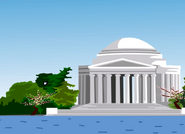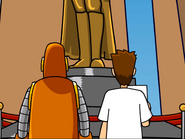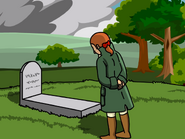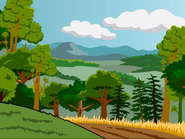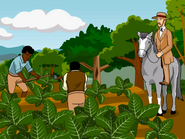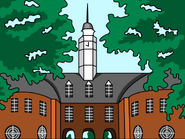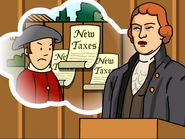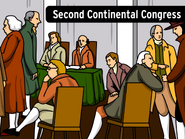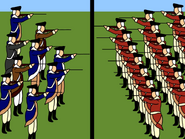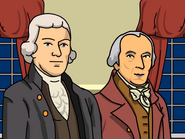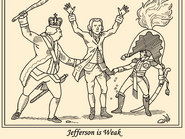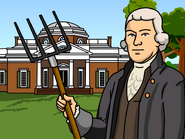Thomas Jefferson is a Social Studies video that was launched to BrainPOP on April 30, 2008.
Summary[]
Tim and Moby are in Washington, D.C., at the Jefferson Memorial.
Tim answers a letter about Thomas Jefferson, and when he finishes, they decide to go to the Washington Monument. Moby is already ahead of him, jumping into the Tidal Basin and swimming towards the Washington Monument, while Tim decides to walk.
Appearances[]
Transcript and Quiz[]
Quotes[]
Gallery[]
FYI[]
Trivia[]
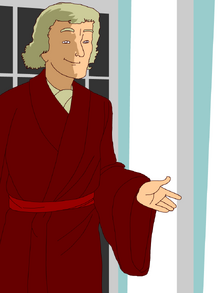
- Jefferson had a lisp and was an awkward public speaker; he gave only two public speeches during his entire presidency.
- Jefferson’s many inventions include a writing box that could fold up into a briefcase, a swivel chair, automatic doors, and a new kind of the plow.
- Jefferson is the only President in U.S. history to serve two full terms without vetoing a single Congressional bill.
- Thomas Jefferson was a polymath, which is similar to a Renaissance man—a person who’s super-smart and has expert knowledge of a bunch of different subjects. Besides being a lawyer and politician, Jefferson was also an architect, naturalist, horticulturist, archaeologist, paleontologist, linguist, inventor, and musician! (He played the violin.)
- In 1786, the Virginia House of Delegates passed the Virginia Statute for Religious Freedom. Written by Jefferson in 1779, it made Virginia the first state or country in the world to guarantee total religious freedom to its citizens. This was one of Jefferson’s proudest achievements.
- As a member of Congress in 1783, Jefferson recommended that American currency should be based on the decimal system, leading to the adoption of the dollar—instead of the pound—as the basic unit of money in the U.S.
- To help create a comfortable, “of the people” atmosphere in the White House, Jefferson often greeted guests in a robe and slippers.
- Jefferson stopped the practice of delivering the State of the Union address in person; he thought it was something only a king would do. Instead, he sent the address to Congress in writing. This continued until Woodrow Wilson brought back the speeches.
In Depth[]

As the primary author of the Declaration of Independence, Thomas Jefferson famously wrote that “all men are created equal” and have “unalienable rights” to “life, liberty and the pursuit of happiness.” Yet during his lifetime, Jefferson owned many slaves. How did he manage to hold such lofty ideals while treating other humans as property?
Believe it or not, for most of his career, Jefferson was an opponent of slavery. In 1769, he proposed a bill in the House of Burgesses to free all slaves in Virginia, which was rejected.
Later, Jefferson’s first draft of the Declaration of Independence included a clause that condemned the British crown for imposing slavery on the American colonies. But to his dismay, it was deleted at the request of delegates from South Carolina and Georgia.
In 1778, he helped pass a bill banning the importation of more slaves into Virginia, which was a big first step in stopping the spread of slavery. And in 1784, he proposed that slavery should be banned in the vast Northwest Territory of the United States.
Jefferson inherited his slaves from his father, along with 5,000 acres of land. He hated the very idea of slavery and wanted nothing more than to see it abolished. However, as a landowner with many debts, he couldn’t legally free his own slaves until he paid off those debts—something he was never able to do. But he made sure that at least some of his slaves were educated or trained in skilled professions.
During Jefferson’s presidency, rumors spread that he was the father of several children born to one of his slaves, a woman named Sally Hemings. Jefferson’s wife had died years earlier, and he never remarried. The alleged relationship with Sally Hemings is still debated today.
Arts And Entertainment[]

If politics hadn’t worked out for Thomas Jefferson, he had a solid back-up plan: architecture. Jefferson was obsessed with the study of buildings and their design, and he became a fairly skilled architect in his own right. He was especially fond of Italian Renaissance architect Andrea Palladio, who worked in the neoclassical style, a school of architecture that was heavily influenced by the buildings of Ancient Greece and Rome.
From an early age, Jefferson had dreamed of building a mountaintop home on the land he inherited from his father. So in 1768, he began construction on his dream home, which he would call Monticello—which means “little mountain” in Italian!
Located on the summit of a 260 meter peak in Charlottesville, Virginia, Monticello is a beautiful mansion designed by Jefferson himself. Over the next four decades, Jefferson kept remodeling and adding to the house, incorporating new ideas—like an octagonal dome—that he picked up during his travels in Europe.
Of course, Monticello was more than just a house. It included a 5,000 acre plantation that was home to hundreds of slaves and workers. The land also included fruit gardens, flower gardens, and a large vegetable garden, which Jefferson used to grow exotic varieties and experiment with new and improved planting techniques.
Today, Monticello is a museum and educational institution that you can visit. It’s the only private home in the United States to be designated a UNESCO World Heritage Site. You can also find Monticello on the back of the U.S. nickel, as well as on $2 bills printed before 1976. The gift shop at Monticello gives out two-dollar bills as change!
Did You Know?[]

For someone who valued education as much as Thomas Jefferson, it makes sense that one of his proudest achievements was the founding of a university. Virginia was already home to the College of William & Mary, from which Jefferson himself graduated. But in his opinion, the school emphasized religion too much, without placing enough emphasis on the sciences. So he started making plans for a new institution of higher learning that would mirror his educational ideals.
A decade after the end of his presidency, those plans finally came to light! The University of Virginia was established in 1819, and Jefferson was personally involved in every detail, from the architectural design of the campus and buildings to the hiring of faculty. Classes began to meet in 1825.
The university was groundbreaking in a number of ways. For one thing, it was the first to offer students many new areas of specialized study, including astronomy, botany, and political science.
The school was also funded by the public, which meant students from less wealthy families could attend. But the university’s most radical concept was the absence of religious doctrine from the curriculum.
Jefferson’s ideals were reflected in his design. His campus layout placed a group of buildings around a grassy quadrangle, with the Rotunda, which houses the library, at the head. The fact that the campus was focused around a library instead of a church was just one thing that separated the school from the other more religious-minded universities of the time.
Until his death, Jefferson often invited students and faculty to dinner at his Monticello home. He was extremely proud of the university—so proud, in fact, that it’s one of only three accomplishments he insisted on putting on his grave.
Etc.[]

Check out some of the ways in which Thomas Jefferson has been memorialized over the years! Jefferson Memorial: This domed building in Washington, D.C. was dedicated on April 13, 1943, the 200th anniversary of Jefferson’s birth. A 5.8-meter-tall bronze statue of Jefferson can be found inside. The interior walls are covered with engravings of passages from Jefferson’s writings.
Mount Rushmore National Memorial: Jefferson is one of four Presidents adorning this South Dakota mountainside, along with George Washington, Theodore Roosevelt, and Abraham Lincoln. Each head in this massive granite sculpture is 18 meters tall! Jefferson was chosen for his role in expanding the country’s territory with the Louisiana Purchase. His part of the memorial was finished and dedicated in 1936.
United States $2 bill: First issued in 1929, the current version of this relatively scarce denomination of U.S. currency features Jefferson’s portrait on the front. Up until 1976, an image of Jefferson’s Virginia home, Monticello, appeared on the reverse side. After that, it was replaced by an engraved version of John Trumbull’s famous painting of Jefferson presenting the Declaration of Independence to the Continental Congress.
Nickel: A side profile of Jefferson has appeared on the front of the five-cent coin since 1938. Up until 2003, Monticello was shown on the reverse. In 2004 and 2005, it was replaced by new designs marking the bicentennials of the Louisiana Purchase and Lewis and Clark Expedition. But in 2006, Monticello was back on the nickel’s reverse, with a new forward-facing image of Jefferson (pictured) on the front!
Quotables[]

Here are some quotations by the third President of the United States! “We hold these truths to be self-evident: that all men are created equal; that they are endowed by their Creator with certain unalienable rights; that among these are life, liberty, and the pursuit of happiness.”
“Liberty is to the collective body, what health is to every individual body. Without health no pleasure can be tasted by man; without liberty, no happiness can be enjoyed by society.”
“The tree of liberty must be refreshed from time to time with the blood of patriots and tyrants.”
“All tyranny needs to gain a foothold is for people of good conscience to remain silent.”
“Educate and inform the whole mass of the people...They are the only sure reliance for the preservation of our liberty.”
“I never considered a difference of opinion in politics, in religion, in philosophy, as cause for withdrawing from a friend.”
“I never will, by any word or act, bow to the shrine of intolerance or admit a right of inquiry into the religious opinions of others.”
“Indeed I tremble for my country when I reflect that God is just, that his justice cannot sleep forever. Commerce between master and slave is despotism. Nothing is more certainly written in the book of fate than these people are to be free.”
FYI Comic[]
There is no FYI comic.
Primary source[]
Thomas Jefferson's Letter to Danbury Baptist Association, January 1, 1802.
Newslea[]
https://newsela.com/read/gl-history-thomas-jefferson-deism/id/27062/

